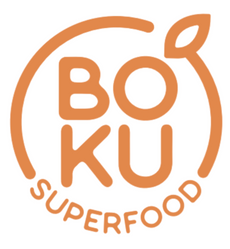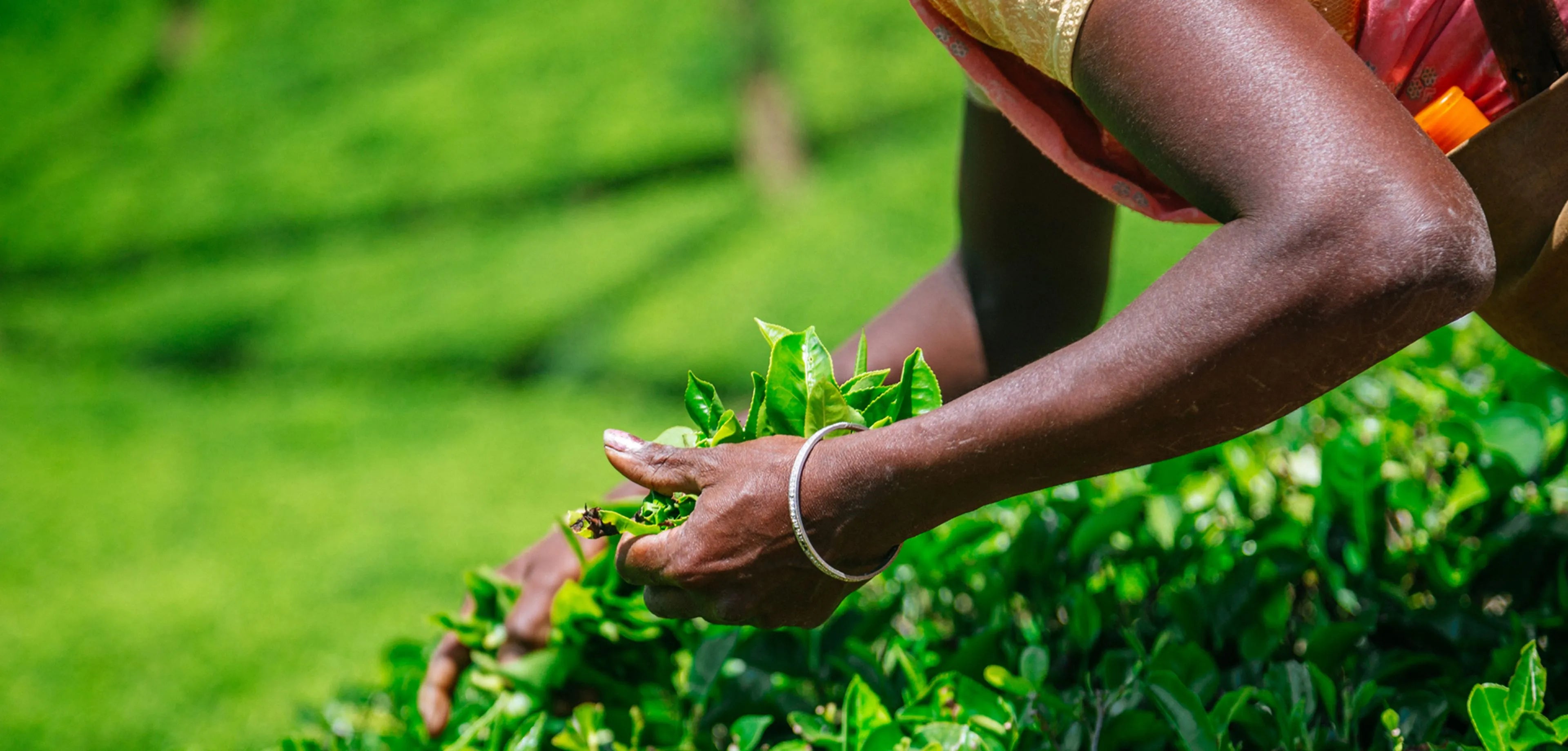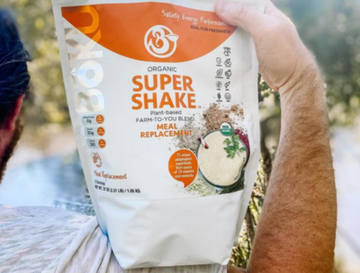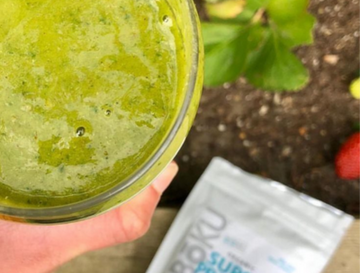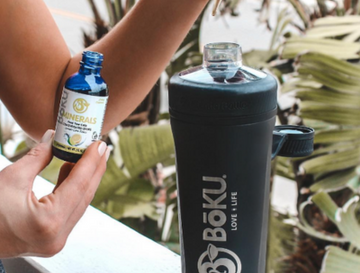55+ Superfoods and Nutrients

Barley Grass Juice
This sweet grass superfood was used medicinally by the ancient Greeks and Romans, and here’s why: it is anti-inflammatory, loaded B-vitamin intake, is loaded with essential minerals like zinc, calcium and iron, has powerful antioxidants, may slow the aging process, and give your immune system a good boost. Even more intriguing is barley grass’ presence of the superoxide dismutase enzyme – an essential defender antioxidant in nearly all living cells.

Nettle Leaf
Nettle is used by almost every culture around the globe. This herb is best known for its substantiated respiratory benefits and its anti-inflammatory properties – it has been used in teas since Medieval times for this purpose. If you’re experiencing allergy-related issues, nettle has got you covered – it is one of nature’s greatest antihistamines. Oh, and the silica and sulfur in the nettle leaf will help your hair stay strong and shine!

Broccoli
Your mom wasn’t just trying to torture you when she made you eat your broccoli. A common veggie around the country and the world, broccoli sometimes is overlooked for its high nutrient content. Broccoli is a powerful cruciferous vegetable full of tons of vitamins and minerals, including Vitamin A ( beta carotine), Vitamin C, and calcium. It is also a great source of fiber, and, like all cruciferous vegetables, broccoli naturally delivers two important phytochemicals — indoles and isothiocyanates. So drink up, baby!

Spinach
Full of iron, calcium and chlorophyl, spinach is another oft-overlooked superfood. The list of incredibly essential vitamins, minerals and phytonutrients is extensive. Let’s go down the list: vitamins A, B & C? Indeed. Fiber? Check. Magnesium? Tons. Zinc? Vitamin K? Phosphorus? You betch ya! Spinach is also loaded with chloryphll, which is what gives it its rich foresty green color. Chloryphll is rich in powerful antioxidants that are said to have to improve liver and organ function!

Kale
This majorly detoxifying leafy green is at the very top of the Aggregate Nutrient Density Index (the ANDI chart). This indicates how packed any given food is with nutrients. Boasting the highest possible score of 1,000 points, kale has many health giving properties and simply put, is considered the most nutrient dense food on the planet. Like other cruciferous vegetables, kale boasts sulfur-creating compounds in the body that are linked to a long list of health benefits including reduction in inflammation, a healthier heart, and improved organ function.

Cabbage
This may sound like a broken record but cruciferous vegetables are amongst the most impactful for our health! Our bodies require the sulfur compounds that these superfoods provide. Like kale and broccoli, cabbage is also a cruciferous vegetable, which provides a major boost in many areas of physiological health. Cabbage is loaded with phytonutrients. In case you don’t know about these powerhouse nutrients, phytonutrients are found in many plants, which the plants use to stay healthy. It only makes sense that they would have a beneficial effect in other organisms, as well; in humans, phytonutrients fight off germs, bugs, and harmful fungus, potentially keeping various diseases at bay.

Nopal Cactus
Nopal cactus is also known as the “prickly pear” cactus, or to Spanish speakers, nopales, and it’s not just any cactus. Nopal is known for its high concentration of both vitamins and antioxidants – most notably, vitamin C and several antioxidant flavonoids. Mexican herbalists take advantage of the nopales’ potential to lower insulin and blood sugar levels after a meal. This high-fiber choice may also lower cholesterol!

Parsley
Parsley is much more than just a curly-headed little garnish. Not only is it packed with Vitamins C, K and A, it has also been used for centuries in folk medicine as a natural detox remedy, antiseptic and anti-inflammatory agent. The compounds in parsley do everything from helping people with anemia to potentially curing you of unpleasant breath!

Maca Root
The maca root is a delicious, butterscotch-flavored adaptogen. Peruvian natives are familiar with its many health boosting properties and have consumed it regularly as a medicine and food for thousands of years! Maca has demonstrated the ability to promote vitality, energy and stamina. In fact Incan runners and warriors would consume this root vegetable before battle and long distance runs. Maca is not only one of the worlds most powerful nutrients, it is also the highest altitude crop and can only grow above 12 thousand feet in the harsh and unforgiving environment of the Andean highlands. Maca was most notably used by the Spanish conquistadors to increase their horse heard size, owing to the plants ability to increase sex drive and boost fertility.

Fine Vanilla Bean
There have been multiple studies showing that a mere whiff of vanilla bean boosts feelings of joy, relaxation, and general emotional well-being. However, few know that fine vanilla bean is also a superfood! Boasting calcium, magnesium, potassium, iron, zinc, vitamin B6 and many other vital nutrients. Vanilla isn’t so plain after all!

Lucuma Fruit
Reverently nicknamed “Inca’s Gold,” this exotic Peruvian fruit has a high vitamin/mineral profile and is known for its abilities to help rejuvenate the skin. Lucuma is also characterized as low-glycemic on the glycemic index, so unlike other fruits, it will not result in any crazy blood sugar spikes after consuming. It must also be noted that Lucuma also has one of the highest ORAC (Oxygen Radical Absorbance Capacity) values in the plant kingdom and may help to increase your bodies ability to absorb and utilize oxygen.

Goji Berry
Goji berries have been used for centuries in China for their incredibly diverse health benefits, boasting immune-boosting polysaccharides and antioxidants. Goji berries – or gou qi zi – are used often in traditional Chinese medicine for longevity, as a tonic to clean the liver and kidneys, and for countless other nourishing purposes.

Hawthorn Berry
Hawthorn berries are chock full of flavonoids, which are said to be very heart-healthy. This is your one stop shop for heart health!

Pomegranate
Fun fact: Biblical scholars say that it was not an apple that Eve plucked, but a pomegranate! These super fruits are delicious, simultaneously tart and sweet, and packed with antioxidants. They also pack an incredible punch of vitamin C, and an excellent fiber boost. Their blood-red juice is an indicator that they are also shown to increase blood flow – a great benefit for heart health!

Blueberry
Blueberry’s brilliant, dark color indicates their richness in ‘anthocyanins’, which are powerful antioxidants that help protect the body from free radicals. Blueberries additionally deliver tons of vitamins, such as fiber and vitamins A, C, E and B complex, along with minerals copper, selenium, zinc and iron.

Acai
Acai is an Amazonian berry with a beautiful rich purple color, and is considered the ultimate free radical killer. In fact, its antioxidant capacity is about 300% more than that of blueberries and grapes, which are both revered for their own antioxidant profiles.

Strawberry
Studies show that simply smelling the sweet aroma of a strawberry can elevate your mood. They are a popular fruit in American households and because of this we may tend to overlook its nutritional benefits! They pack a punch of vitamin C, have anti-inflammatory properties, and are filled with minerals that contribute to an overall healthy lifestyle.

Tart Cherry
Tart cherries are saturated with a dark, antioxidizing pigment called anthocyanin, which gives them a dark red color. Tart cherries also contain beneficial phenolics and might just knock out insomnia, as they contain melatonin!

Cranberry
An amazing kidney cleanser, cranberries are known for cleaning and protecting the urinary tract! The USDA Nutrient Data Laboratory states that cranberry has a concentration of nine minerals, which include calcium, magnesium, potassium, selenium, zinc and phosphorus. Cranberry juice also has 15 vitamins, which include vitamin C, thiamine, niacin, vitamin B6, B12 and vitamin A. Other nutritious constituents in cranberry juice include protein, carbohydrates and fiber.

Red Raspberries
Raspberries contain ellagic acid, which help your body to balance the damage of free radicals. However, ellagic acid is not the only well-researched phyto-nutrient component of the raspberry. Raspberry’s flavonoid content is also well documented. The key flavonoids are: quercetin, kaempferol and anthocyanins, all of which give raspberries their rich, red color.

Vermont Maple Syrup
This underappreciated natural sweetener includes a host of vitamins and minerals, as well as some powerful antioxidants. Among maple syrup’s various compounds is a newly identified one named Quebecol, which is a compound uniquely created when Maple tree sap is boiled and turned into syrup.

Himalayan Pink Crystal Salt
The history of Himalayan Pink Salt dates back over 4 billion years. Found high in the Himalayas that were once once the ocean floor, this mineral rich salt is replacing table salt in more and more households. Himalayan salt has 99% sodium chloride content and its rich content of minerals helps to foster a healthy PH level in the body. Many people use this salt as a salt water flush, balancing stomach acids and aiding in digestion.

Kelp
Kelp is a form of algae that grows ubiquitously in the ocean, in many varieties. This slippery green seaweed is loaded with potassium, boron, soluble fiber and iron, and vitamins A, B12, C and E. But its true claim to fame is its tremendously high concentration of iodine – the highest of any food. Iodine is a necessary nutrient – thyroid hormones cannot be synthesized without this essential mineral. Bonus – it also has tons of calcium and magnesium!

Reishi
Reishi mushroom has been valued in traditional Eastern medicine for thousands of years, earning itself the nickname “the mushroom of immortality.” Traditionally used for general wellness and longevity, Reishi is a powerful adaptogenic (helps the body deal with stress) and also provides immune-support. While edible, reishi mushrooms are tough and bitter – our Boku shroom blend is a great way to get the benefits of reishi in a much more convenient, tastier way! Modular is a powerful Shopify theme that will set you apart from the rest with Mosaic, Image with text, and Slideshow sections.

Maitake

Chaga
Chaga is among the most popular of the medicinal mushrooms. Chaga is rich in antioxidants and powerful immune-supporting beta glucans. It is known for its adaptogenic properties that can help to support healthy stress response.

Mesima

Lion's Mane
Lion’s Mane mushroom has a long history in traditional Eastern medicine. This mushroom contains many bioactive compounds, such as erinacines and hericenomes, both known for their use in supporting cognitive function.

Turkey Tail
The beautiful Turkey Tail mushroom is native to forests around the world. This mushroom contains a protein called TVC, which helps support healthy immune response. Turkey tail mushroom is also rich in antioxidant flavonoids. Its also a useful source for prebiotics, which keep your gut happy and healthy!

Shiitake

Blazei
Originally from the rainforests of Brazil, blazei has a long history of use in traditional Brazilian folk medicine. Research has shown blazei has high levels of immune-boosting polysaccharides, making it especially useful for staying healthy in the modern world.

Poria
Poria is also known as Fu Ling, and is an oft-used medicinal mushroom in Traditional Chinese Medicine. Rich in polysaccharides and antioxidant triterpenoids. Poria is treasured for being a source of pachymic acid, which is hailed as an immune booster.

Suehirotake
Also known as the “Split-fold mushroom”, suehirotake is known for its particular polysaccharide structure, which has been used in Eastern and Western medicines to support immune health. Suehirotake is like a Super-Hero také for your immune system!

Hiratake
With evidence of use going back over 3000 years in Asian cultures, Hiratake is a mushroom that is prized for its culinary use as well as its health boosting benefits. In Traditional Chinese Medicine (TCM), this mushroom is often used for muscle, joint and tendon relaxation, to improve blood flow and to support healthy kidney function. The may be as good for the planet as they are for your body, too! Recently, Hiratake mushrooms have been researched for their ability to degrade environmental toxins, such as hydro-carbon contaminants.

Agarikon
Agarikon (Laricifomes officinalis) is found in old-growth forests across Europe, Asia, and North America. It has been used as a food and traditional medicine for thousands of years! Agarikon boasts tremendous immune boosting and adaptogenic properties. Agarikon has a long history of use – so long that it was even found in the stomach of Ötzi the Iceman (from ~3200 BC!)

True Tinder Polypore
True Tinder Polypore mushrooms have a long history of use – there’s even record of Greek physician Hippocrates using true tinder polypore in his practice way back in 370 BC! An amazing adaptogenic, true tinder polypore is also known in Traditional Chinese Medicine to work as an anti-inflammatory and immune booster.

Sprouted Flax
Sprouted flax benefits from the vitamin and lignin-boosting germination process to provide a powerful boost of nutrition. Sprouting is also helpful to increasing bioavailability of the protein and minerals found in flax seed.

Broccoli Sprouts
Broccoli sprouts are a great source of sulfurophane, and can help support cardio vascular and respiratory health, brain function and skin health.

Pumpkin
Boasting myriad health benefits, we think pumpkin deserves attention year-round! This hearty squash offers a major dose of vitamin A, plus other essential nutrients like vitamin C, potassium, copper, manganese, vitamin B2, vitamin E and iron. Pumpkin sprouts provide these essential minerals, vitamins, and phytonutrients in a small but powerful package. The germination process makes the nutrients in pumpkin sprouts especially easy for your body to absorb and assimilate. Pumpkin fiber helps regulate digestion, assists in keeping blood sugar steady, and acts as a prebiotic for gut health. Pumpkin protein is one of the richest plant sources of omega-3 fatty acids, which help regulate cholesterol and inflammation.

Cauliflower Sprouts
Sprouts are a powerhouse of nutrition. Civilizations over the past 5,000 years have considered sprouts a veritable fountain of youth and a nutritional staple. They deliver amino acids, vital vitamins and minerals, chlorophyll and antioxidants, and the germination process makes all of these nutrients more bio-available!

Kale Sprouts
Benefiting from the nutrition-concentrating germination process, kale sprouts are a good source of antioxidant vitamins as well as necessary minerals potassium and calcium.

Cabbage Sprouts
Cabbage sprouts are the young sprouts of the familiar cruciferous vegetable, packing a dense nutrition profile into a tiny package. They are high in phytonutrients, vitamin C and beta-carotene. Cabbage sprouts are also a good source of necessary trace minerals like iodine and sulfur.

Blackberry
Blackberries are an excellent brain food; their high concentration of manganese is useful in fueling cognitive function. Another of the blackberry’s sought-after qualities is its impressive stock of vitamins and minerals. Blackberries also contain soluble and insoluble fiber, which are beneficial catalysts for helping regular bowel movements.

Alpha-Amylase
Amylase is the digestive enzyme that converts starch and glycogen into simple sugars. Digestive enzymes are particular proteins that can support digestion AND assist in the nutrient absorption of foods.

Cellulase
Cellulase is a naturally occurring digestive enzyme that breaks down cellulose, the main element in plant cell walls and vegetable fibers, so it helps your body digest plants! Digestive enzymes are particular proteins that can support digestion AND assist in the nutrient absorption of foods.

Lipase
Lipase is a digestive enzyme that helps your body digest fats. Digestive enzymes are particular proteins that can support digestion AND assist in the nutrient absorption of foods.

Acerola Cherry
In studies of naturally occurring sources of vitamin C, acerola has consistently been the leader of the pack! With reportedly higher amounts of vitamin C than even oranges and strawberries, and only outdone by rosehips, acerola is a real vitamin C booster. But that’s not all: acerola was also found to be a very significant source of vitamin A!

Aloe Vera
Aloe vera is a super succulent, containing a variety vitamins, minerals, saccharides, amino acids, anthraquinones, enzymes, lignin, saponins and salicylic acids. It is a source of antioxidant vitamins A, C, and E, plus vitamin B12, folic acid, and choline! Aloe vera has a strong traditional history of medicinal use, both topically to soothe skin, and internally to help optimize digestive function and soothe common issues.

Artist's Conk
The Artist’s Conk grows on dead and fallen trees in forests around the world. This mushroom is traditionally considered to have antiviral, antibacterial, antifungal, and anti-inflammatory properties. Plus, they are full of additional antioxidant vitamins and minerals!

Agave
Agave is native to several areas of the Americas, including Mexico and the Caribbean. It is rich in phytonutrients and vitamins C, B6, K, and Folate, as well as minerals including potassium, calcium and selenium. Agave Inulin is a soluble or dietary fiber found in the root of the plants and is also known as a prebiotic. Prebiotics help keep your gut healthy, strengthen your immune system, and help with absorption of necessary nutrients.

Alpha-Galactosidase
Alpha-galactosidase is an enzyme used to digest complex carbohydrates. Digestive enzymes are particular proteins that can support digestion AND assist in the nutrient absorption of foods.

Beet
You are probably already familiar with this rich, red, superfood. Beets are packed with essential nutrients – they are a great source of fiber, folate, manganese, potassium, iron, and vitamin C. Beetroot has long been associated with numerous health benefits, including improved blood flow, lower blood pressure, and increased exercise performance.

Bromelain
Bromelain is a digestive enzyme found in pineapples. Bromelain has a history of folk medicine use, and is known to aid in the digestion of proteins.

Brown Rice
The amino acids found in brown rice promote healthy circulatory, kidney, and liver function. Brown rice is also high in cysteine, which may help enhance lung health, endurance, and detoxification.

Cacao
Although similar in name and flavor, there is a BIG difference between the cacao we use and the cocoa powder you know from hot chocolate packets! Cacao has an incredible amount of antioxidants, with an ORAC score of 98,000. It is also the highest plant-based source of iron, with nearly three times more iron than beef (plus more calcium than cow’s milk)! Cacao is also a good source of magnesium, one of the most deficient minerals in the standard Western diet; magnesium is crucial to heart health and cognitive function. Plus, cacao just might brighten your day, with tryptophan, tyrosine, and phenylethylamine that are all known for their mood-boosting effects. Fun fact: Cacao beans were used as a ritual beverage and a currency in pre-Columbian Mesoamerican civilizations!

Carob
Ancient Greeks were the first to grow carob trees, which are now grown all over the world, from India to Australia. Carob pods taste similar to chocolate, and boasts a roster of health benefits: fiber, antioxidants, vitamins A & B, as well as the essential minerals copper, calcium, manganese, potassium, magnesium, zinc, selenium, and protein.

Coconut Milk
Coconut milk is a delicious base for many of Indian, Thai, Hawaiian and South American dishes. But this superfood has a lot to offer despite being an indulgent treat! Coconut milk is rich in short- and medium- chain triglycerides, known as “healthy fats.” These fats digest slowly, and are more likely to be converted to energy rather than stored in the body like other fats. Coconut milk is also a source of vitamins C and E, both known for being powerful antioxidants.
Coconut milk boasts a great balance of electrolytes like potassium, magnesium, and phosphorous. It is also known to boost HDL “good” cholesterol levels and immune function.

Enoki
Enoki mushrooms are native to China, Japan, and Korea. These mushrooms provide a great source of B vitamins, phosphorus, iron, selenium, and calcium, as well as high levels of linoleic acid (a fatty acid), polysaccharides, and other nutritional phytochemicals and antioxidants. Thanks to this strong nutritional profile, enoki mushrooms support healthy immune, cardiovascular, nerve, and liver function.

Ginger
Ginger is a powerful spicy root that’s popular as a stomach soother in folk medicine traditions. Beyond it’s tummy helping properties, it also contains vitamin C, magnesium and potassium.

Hemp
Hemp cultivation goes back as far as recorded human history. It has been cultivated since the beginning of agriculture, starting in Central Asia before branching out worldwide. Its first use was as food for humans and animals in China and India. Hemp seeds are incredibly nutritious and rich in healthy fats, protein and various minerals. They are rich in the essential fatty acids linoleic acid (omega-6) and alpha-linolenic acid (omega-3). The seeds also contain high amounts of the amino acid arginine, which may support cardiac health.

Honey Mushroom
The honey mushroom is one of the largest and longest-living organisms on Earth. In fact, it is reported that the largest organism on the planet is a honey mushroom that covers over 2400 acres in Oregon, that is estimated to be up to 8650 years old! The honey mushroom has a long history of use in folk medicine throughout Eastern Europe and China. As it is very high in polysaccharides, honey mushrooms offer immune support and powerful antioxidant function. Fun fact: the honey mushroom can glow in the dark!

Marshmallow Root
Marshmallow has been used for over 2000 years as both a food and a medicine. Marshmallow root contains a gummy substance called “mucilage.” When mixed with water, mucilage forms a soothing gel that coats the throat and stomach. Other beneficial nutrients found in marshmallow include flavonoids, antioxidants, pectin, proteins, coumarin, and quercetin.

Matcha
Matcha is the whole, powdered leaf of carefully selected, specially grown green tea plants. Rich in catechins and antioxidants, matcha has a long history of traditional use in China and Japan. Because matcha is made with the whole leaf, it offers the more nutritional value than standard, steeped green tea. Matcha is also a great source of the compound L-theanine, which is known to work synergistically with the caffeine naturally present in matcha to promote alertness and help avoid jitters and energy crash.

Monk Fruit
Monk fruit, also known as luo han go, is a melon native to China and Thailand. Its name refers to the monks who cultivated it centuries ago. Monk fruit has a history of use as a medicinal tea in Traditional Chinese Medicine, to soothe sore throats and relieve excessive phlegm. Today, it is also used as a healthy sugar-free sweetener, since it’s over 100 times sweeter than sugar!

Nutritional Yeast
Though it’s often used for its dairy-free yet delightfully cheesy flavor, nutritional yeast lives up to its “nutritional” name! Nutritional yeast is a great source of protein, B vitamins and trace minerals. It contains contains all nine essential amino acids, making it a complete protein. Nutritional yeast is also a great source of B Vitamins, which are often lacking in the standard American diet. It is a useful source of trace minerals, such as zinc, selenium, manganese and molybdenum. Trace minerals are involved in metabolism, growth, nervous system function, and immunity. To top it all off, nutritional yeast contains two main carbohydrates — alpha-mannan and beta-glucan, which have been known to boost immunity and may even help promote healthy cholesterol levels.

Pea Protein
Pea protein is a complete protein and a great source of iron. It may aid muscle growth, weight loss and cardiovascular health.

Psyllium
Psyllium is fiber from the husks of Plantago ovata seeds. The fiber in psyllium promotes healthy bowel function by soaking up water in your digestive tract and creating bulkier stools. Psyllium is also a prebiotic, which means it promotes healthy probiotics to grow in your gut.
These probiotics are essential for healthy immune function, and critical to your body’s ability to fight infection, reduce inflammation, and maintain healthy tissue and cells.

Red Dulse
This nutrient-rich form of alga has been a food source for more than a thousand years around the world. This little food from the sea has major nutritional benefits! Rich in minerals like calcium, magnesium, and iron, dulse promotes healthy bone density. Also high in potassium, which contributes to healthy blood pressure. Red dulse also boasts vitamins A and C, both vital antioxidants that help the body fight free radical damage. Often high in iodine, dulse may help keep your thyroid working normally. Plus, red dulse is a great source of omega-3 fatty acids, which are necessary for proper brain and nervous function.

Rhubarb
In Europe and North America, rhubarb is often eaten cooked and sweetened. In Asia, its roots are used in traditional medicine. It is a very good source of vitamin K1, as well as a useful source of fiber.

Sacha Inchi
Sacha inchi is native to parts of South America and the Caribbean. It was traditionally consumed by indigenous groups in Peru, which is why it is often referred to as the Inca nut. Sacha inchi seeds are high in protein, fiber, and healthy fats. They also contain other nutrients, such as phosphorus, potassium, magnesium, calcium, and zinc. Plus, they have antioxidants!

Tremella
Tremella has been used in traditional Chinese medicine for centuries. Due to its high polysaccharide content, it may support immune, skin, and heart health.

Turmeric
Turmeric has been used in India for thousands of years as both a spice and medicinal herb. It is best known for giving curry its color! Turmeric’s biggest nutritional benefit is from curcumin, a powerful anti-inflammatory and antioxidant.

Chlorella
Chlorella is a nutrient dense green algae. It is about 50% protein, and provides all nine essential amino acids, making it a complete protein source. Chlorella is also a good source of iron, with the added benefit of being rich in Vitamin C (which helps your body absorb iron!) Chlorella is also a source of omega-3 fatty acids.

Lactase
I bet you can guess what digestive enzymes are! Yes, they are in fact enzymes that aid in the digestion of foods. More specifically, Amylase, Protease (3 different potencies), Bromelain, Cellulase, Lipase, Alpha-galactosidase and Papain are particular proteins that can support digestion AND assist in the nutrient absorption of foods. Lactase is the enzyme that helps break down lactose.

Lactobacillus Sporogenes
Lactobacillus Sporogenes is a beneficial probiotic bacteria that promotes a healthy balance of gut flora and fauna. Its scientific name is actually a misnomer because the root “lacto” insinuates that this powerful intestinal bacteria comes from cows. It is actually derived from soil, not milk – so it’s vegan!

Protease
I bet you can guess what digestive enzymes are! Yes, they are in fact enzymes that aid in the digestion of foods. More specifically, Amylase, Protease, Bromelain, Cellulase, Lipase, Alpha-galactosidase and Papain are particular proteins that can support digestion AND assist in the nutrient absorption of foods. Protease is the enzyme the body uses to digest protein!

Red Clover Sprout
Clover sprouts offer a variety of phytonutrients that are especially concentrated thanks to germination! Clover sprouts provide protein, fiber, calcium, iron, vitamin C and folate.

Spirulina
Spirulina is a blue-green algae found mainly in Hawaii, Mexico and other tropical regions. Spirulina is full of countless nutrients, including powerful chlorophyll and beneficial fatty acids. It is also incredibly high in protein – so high, in fact, the Aztecs called this green stuff “Tecuitlatl” and used to consume it as a primary source of protein and sustenance! Spirulina is also great for keeping in shape, as it’s known to promote weight loss and the development of lean muscle tissue. It is even often used to help treat infections and fight bacteria in the body.

Sweet Mesquite
Although you may know the name from barbecue, the nutty, sweet seed pod of the mesquite tree is a high-protein, highly nutritious food, rich in iron, lysine, manganese, potassium, and zinc.

Organic Goldenberries
Goldenberries are a deliciously tangy fruit grown in the Andes that are known for their antioxidant content, fiber, and an array of vitamins and nutrients.

Bacillus Coagulans
5 billion colony-forming units of this highly-beneficial bacteria supports the gut and immune system. Vegan, safe and non-toxic.
